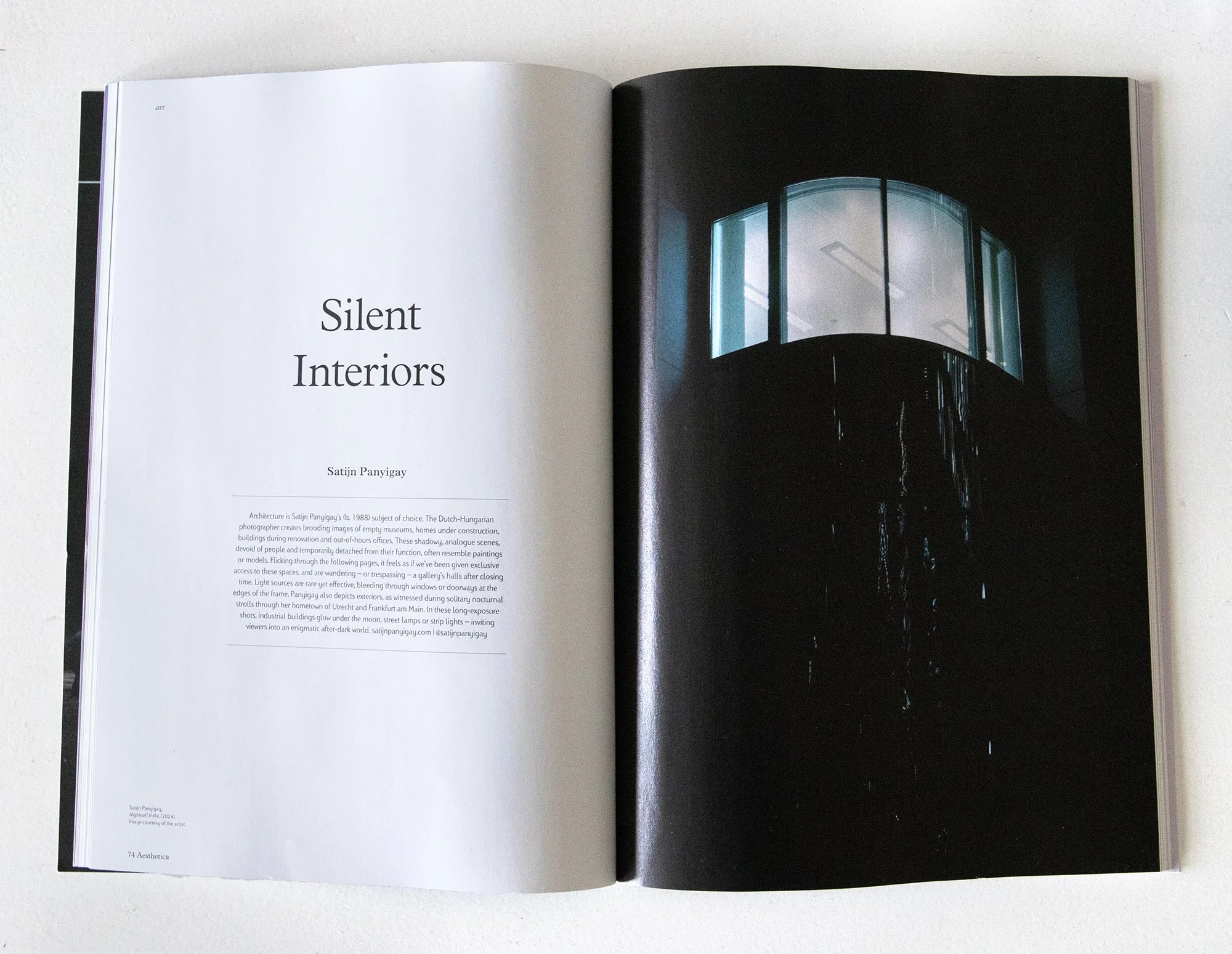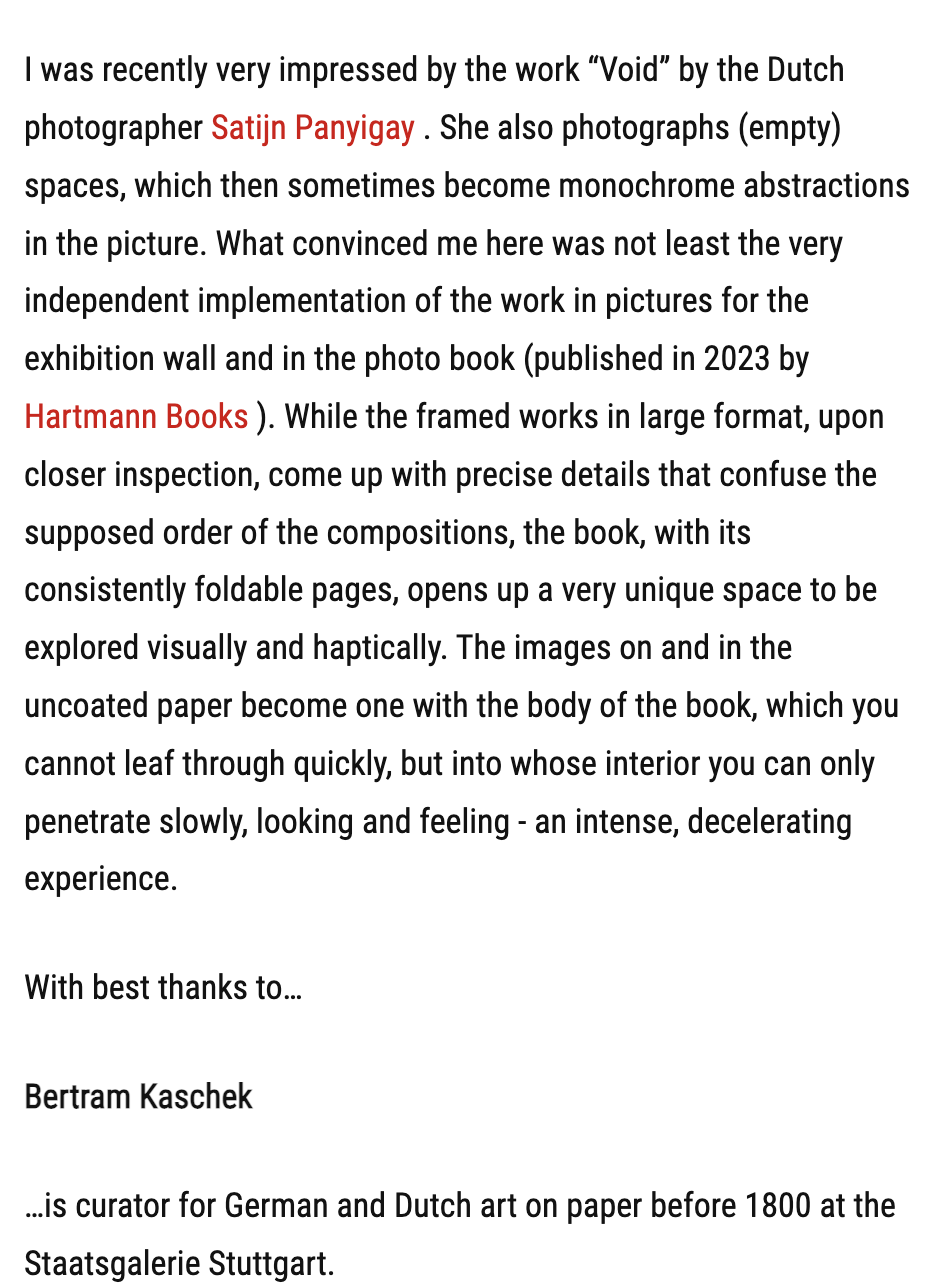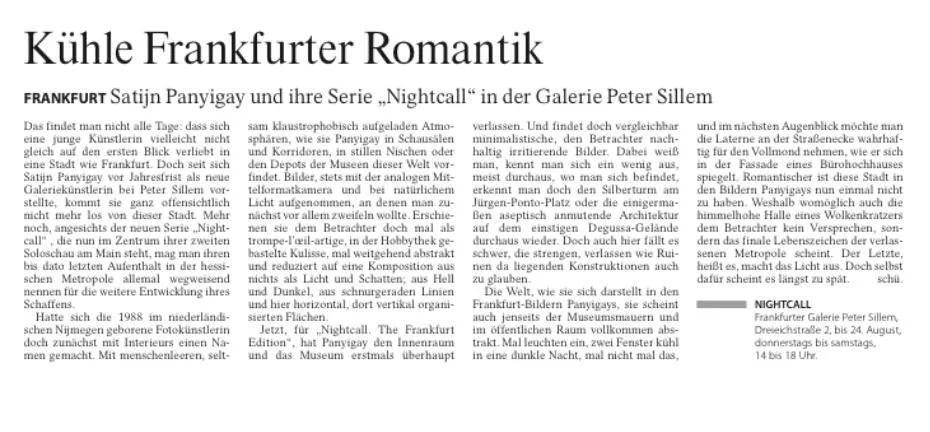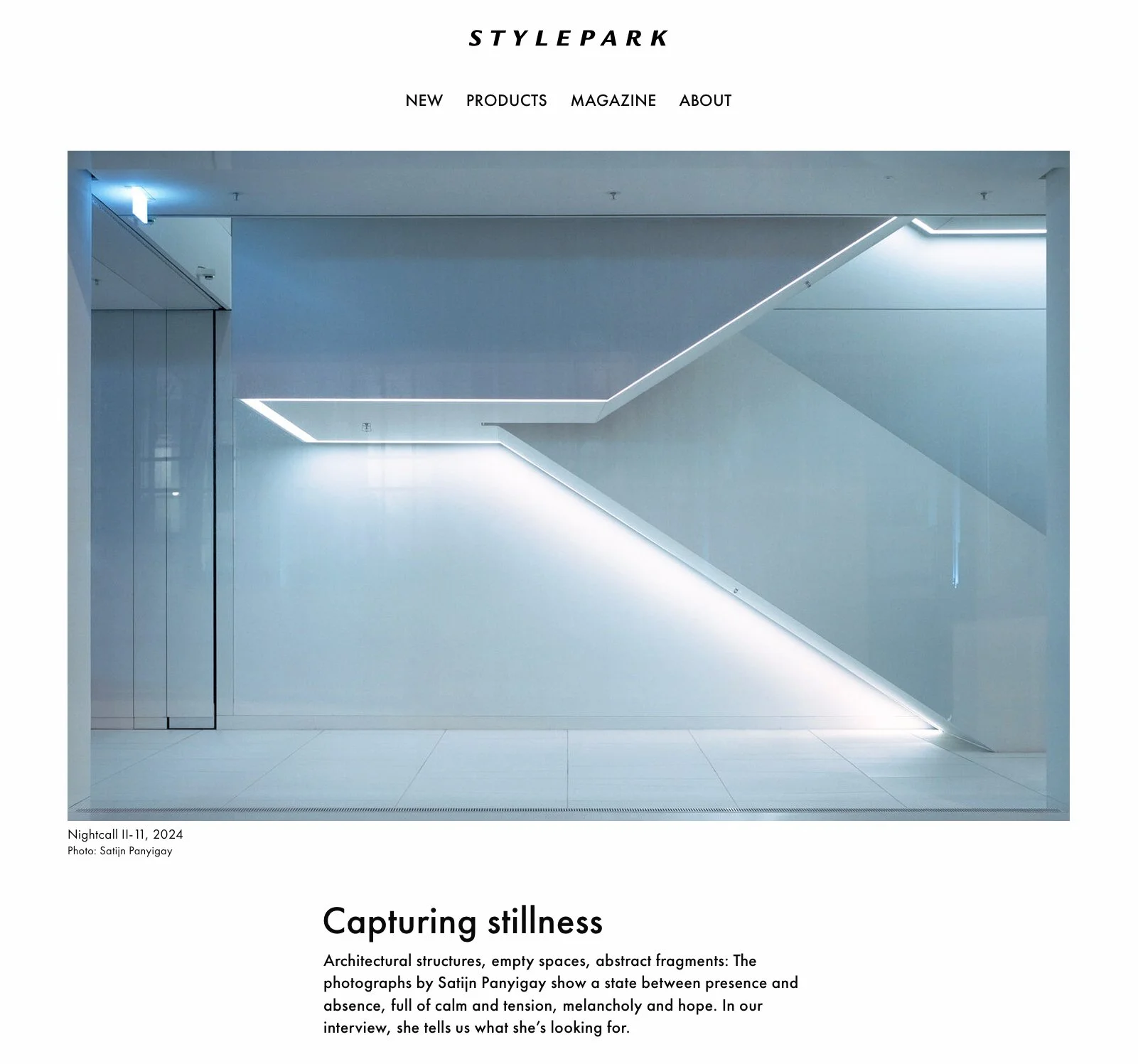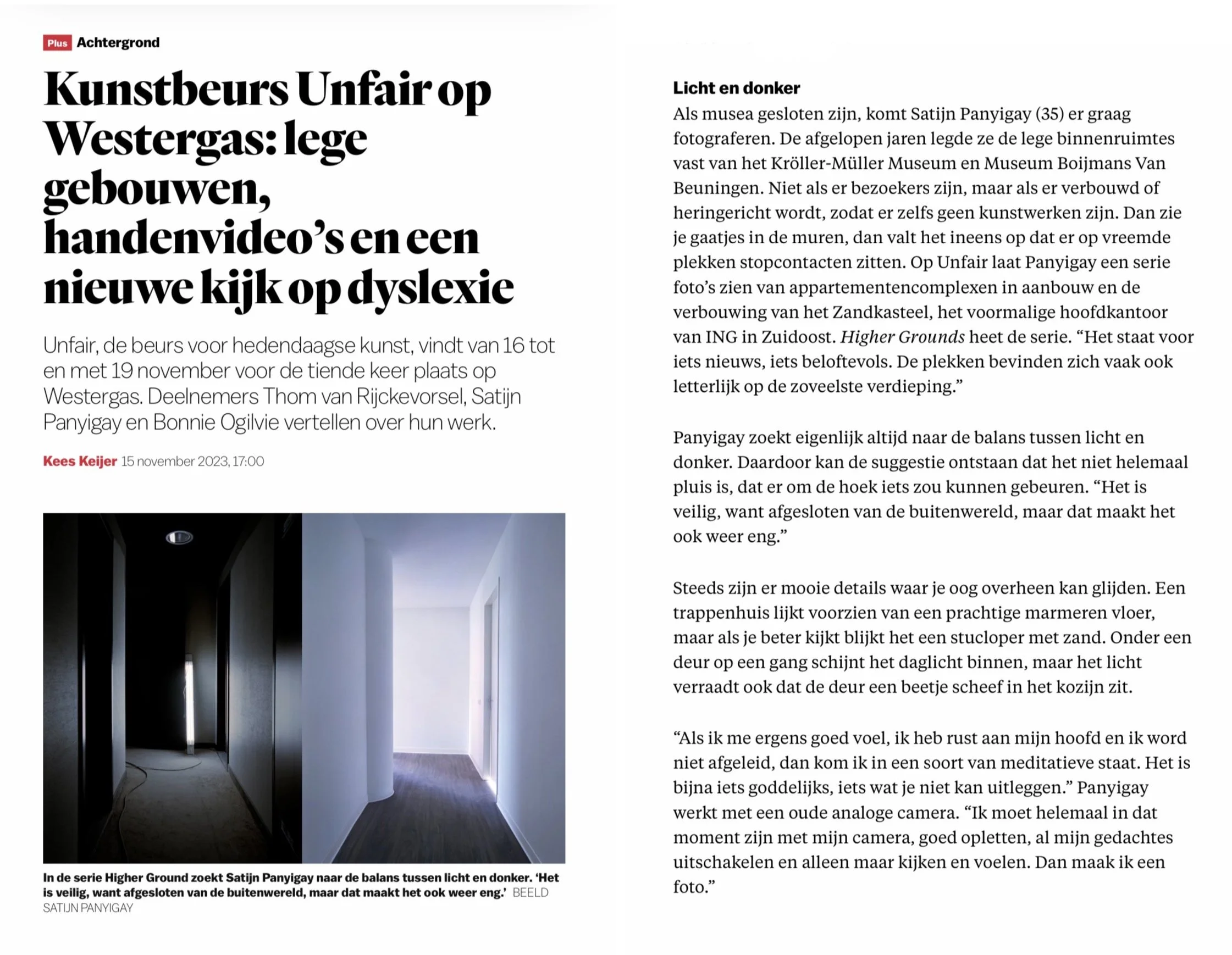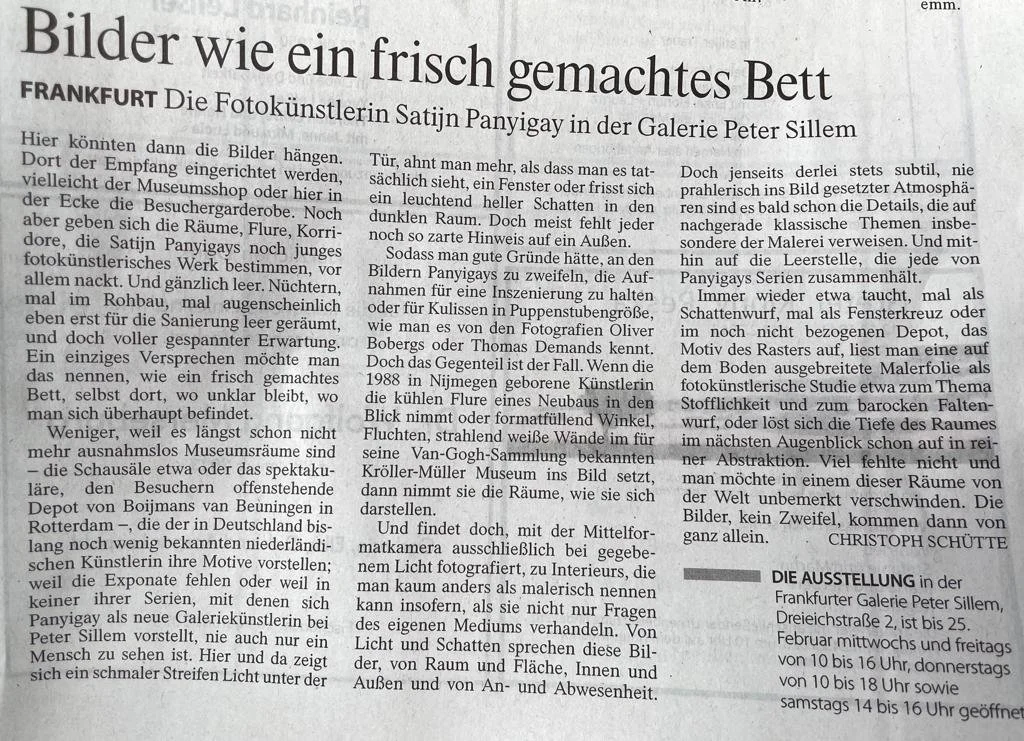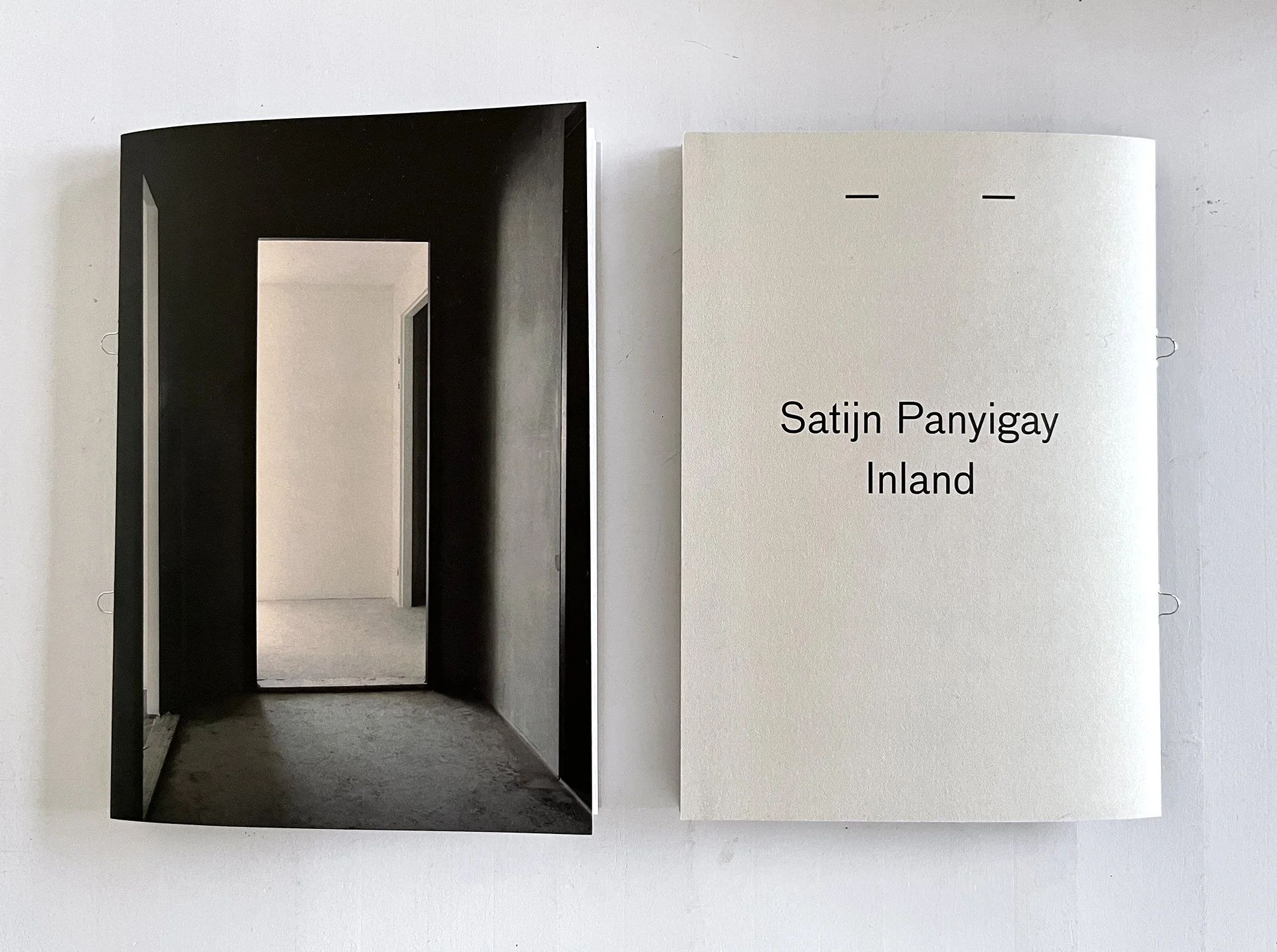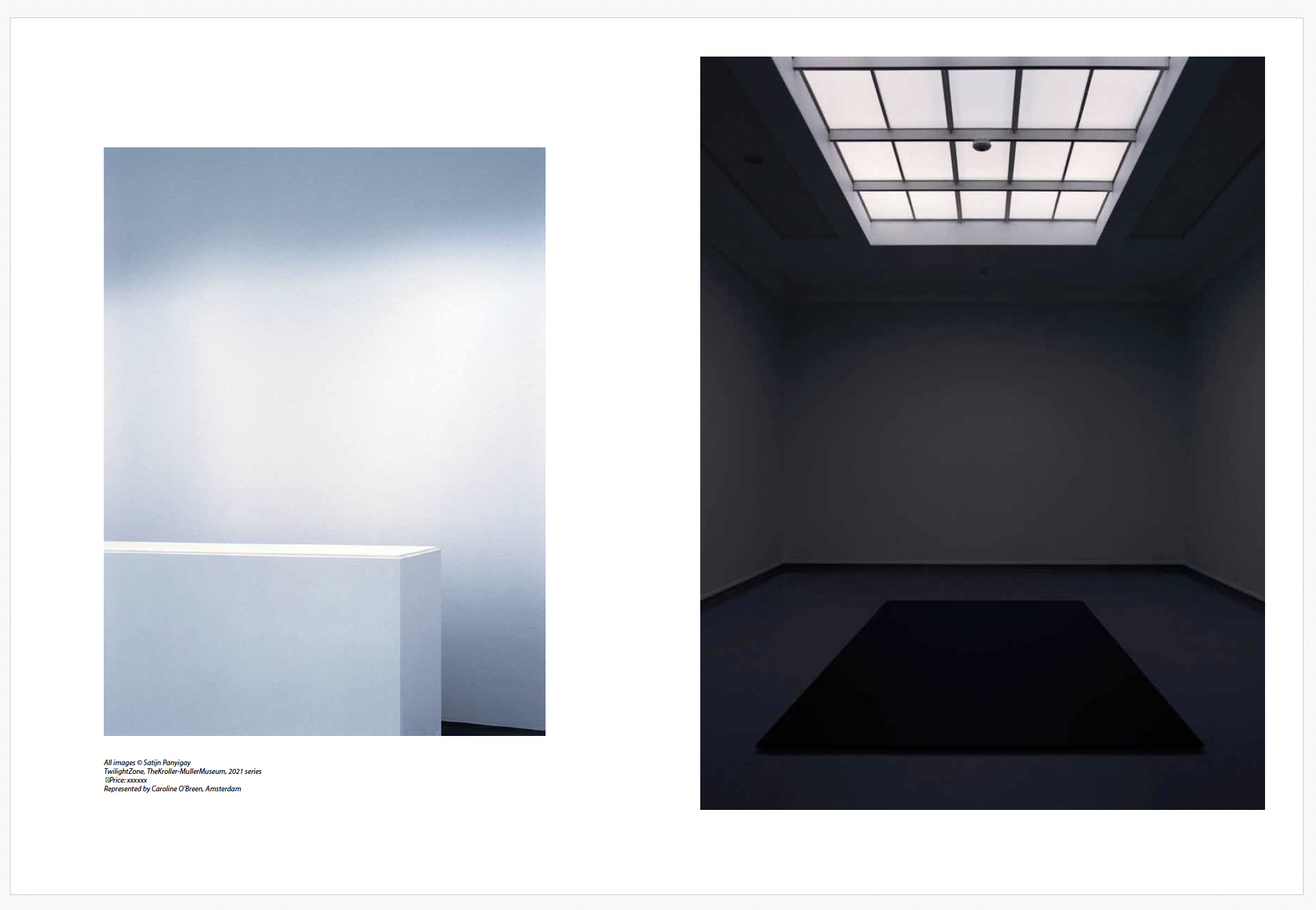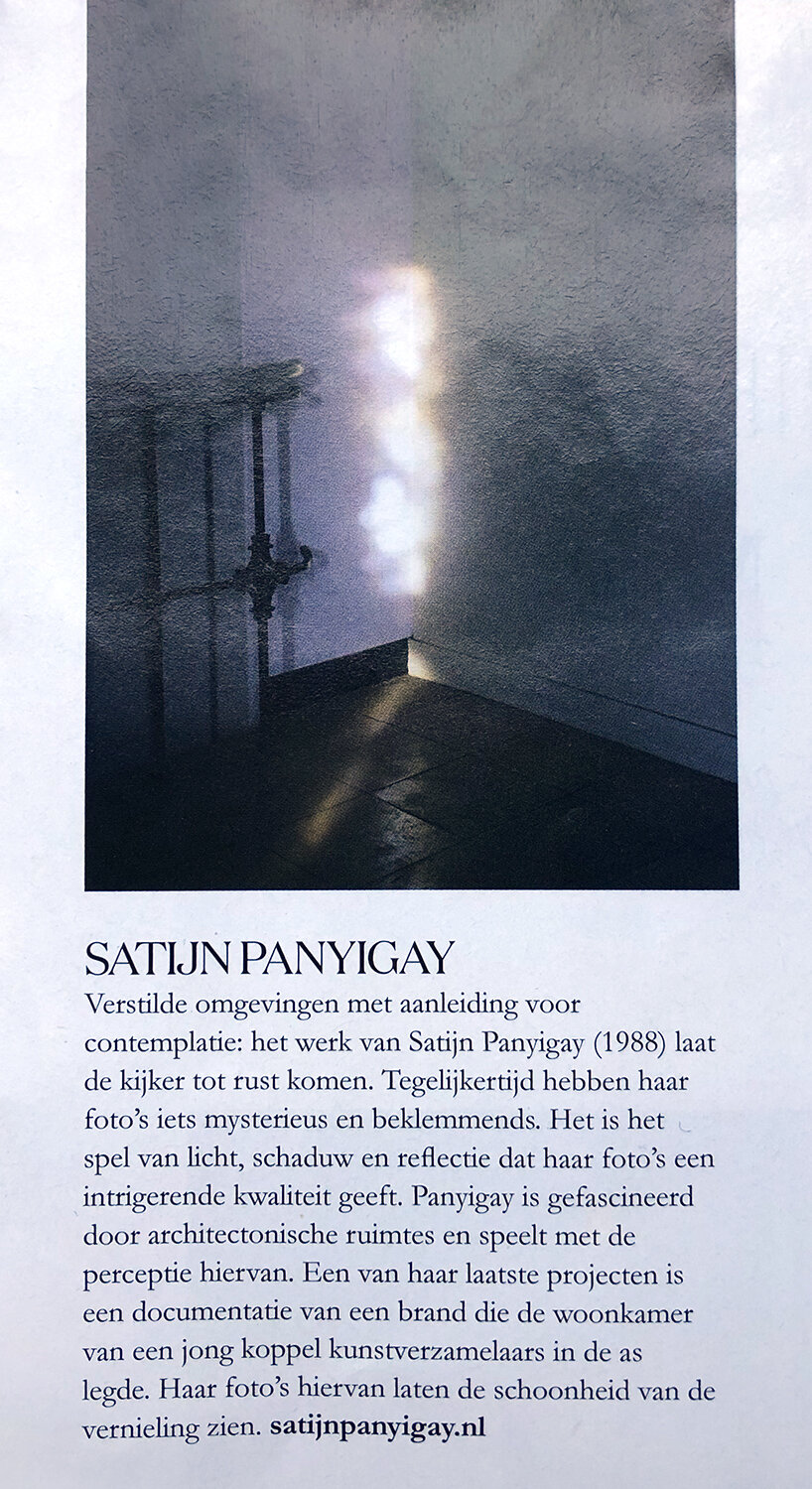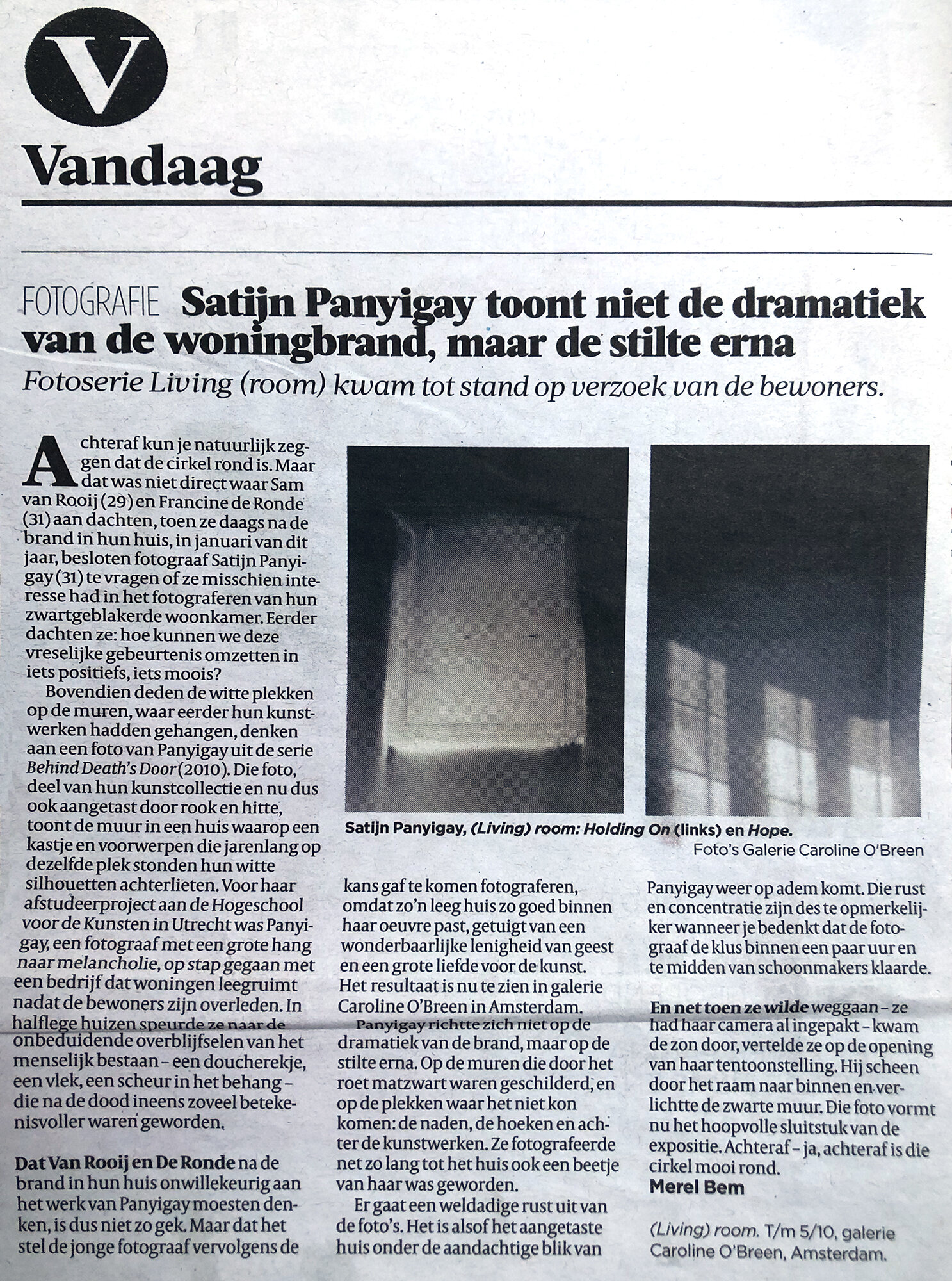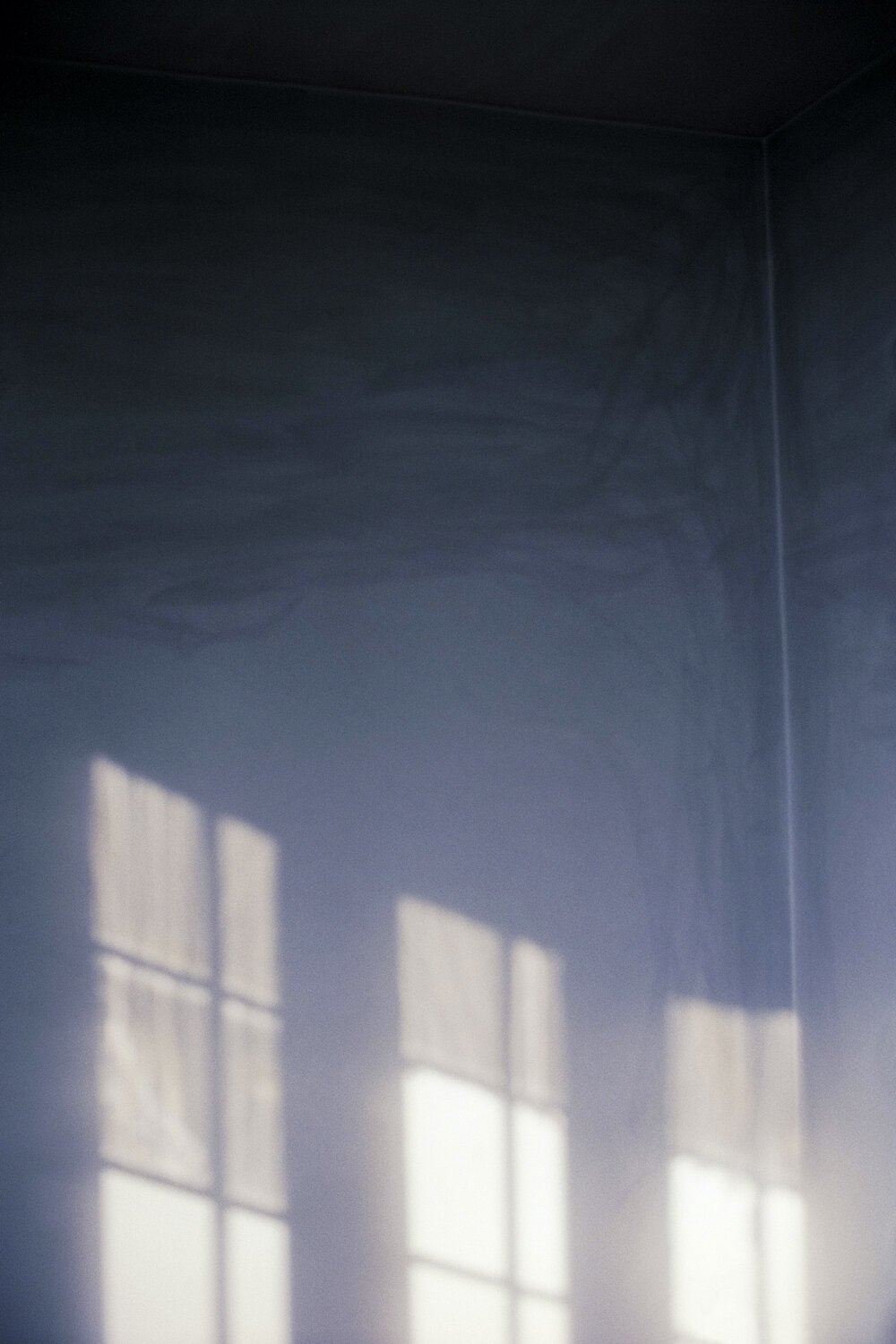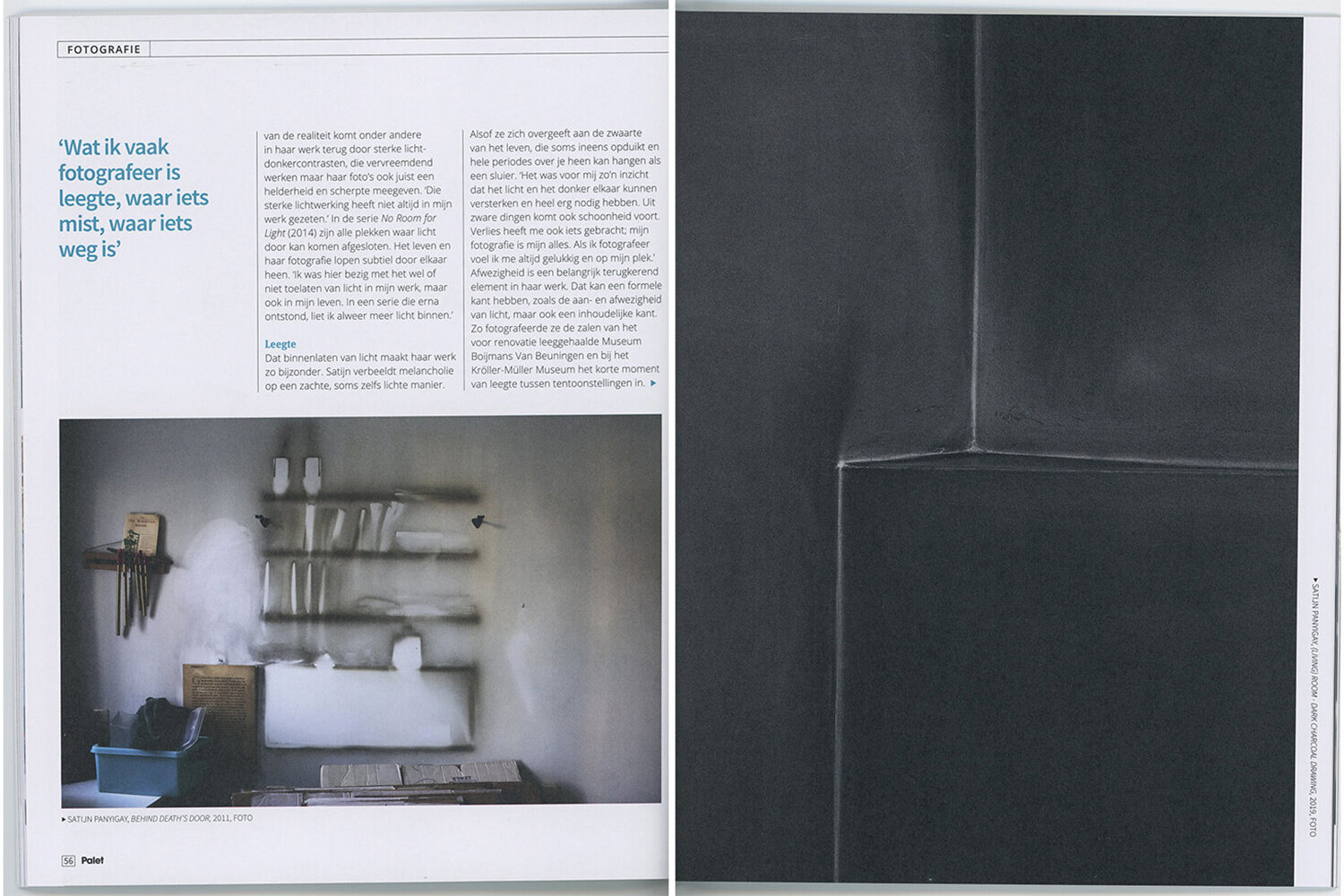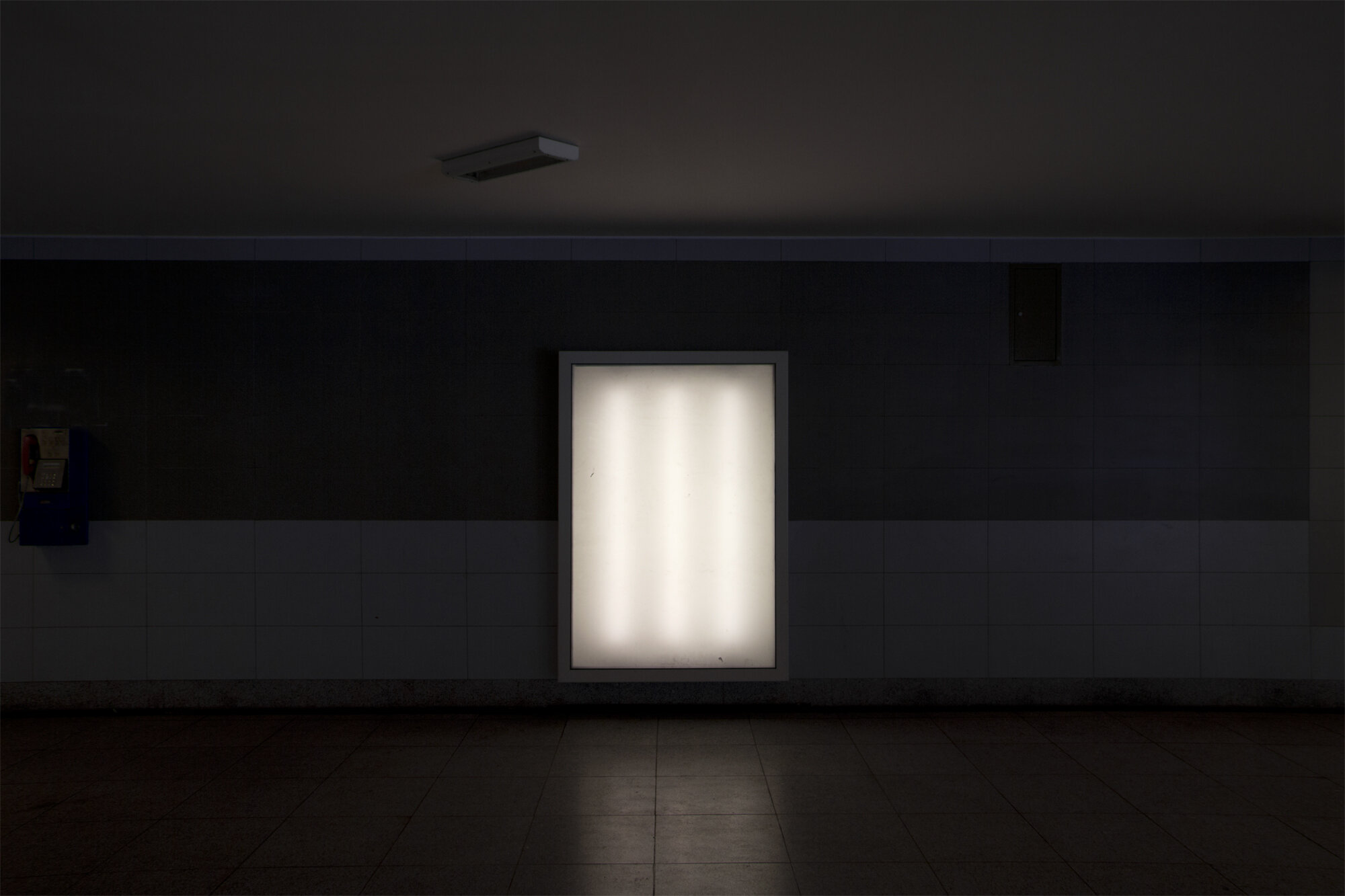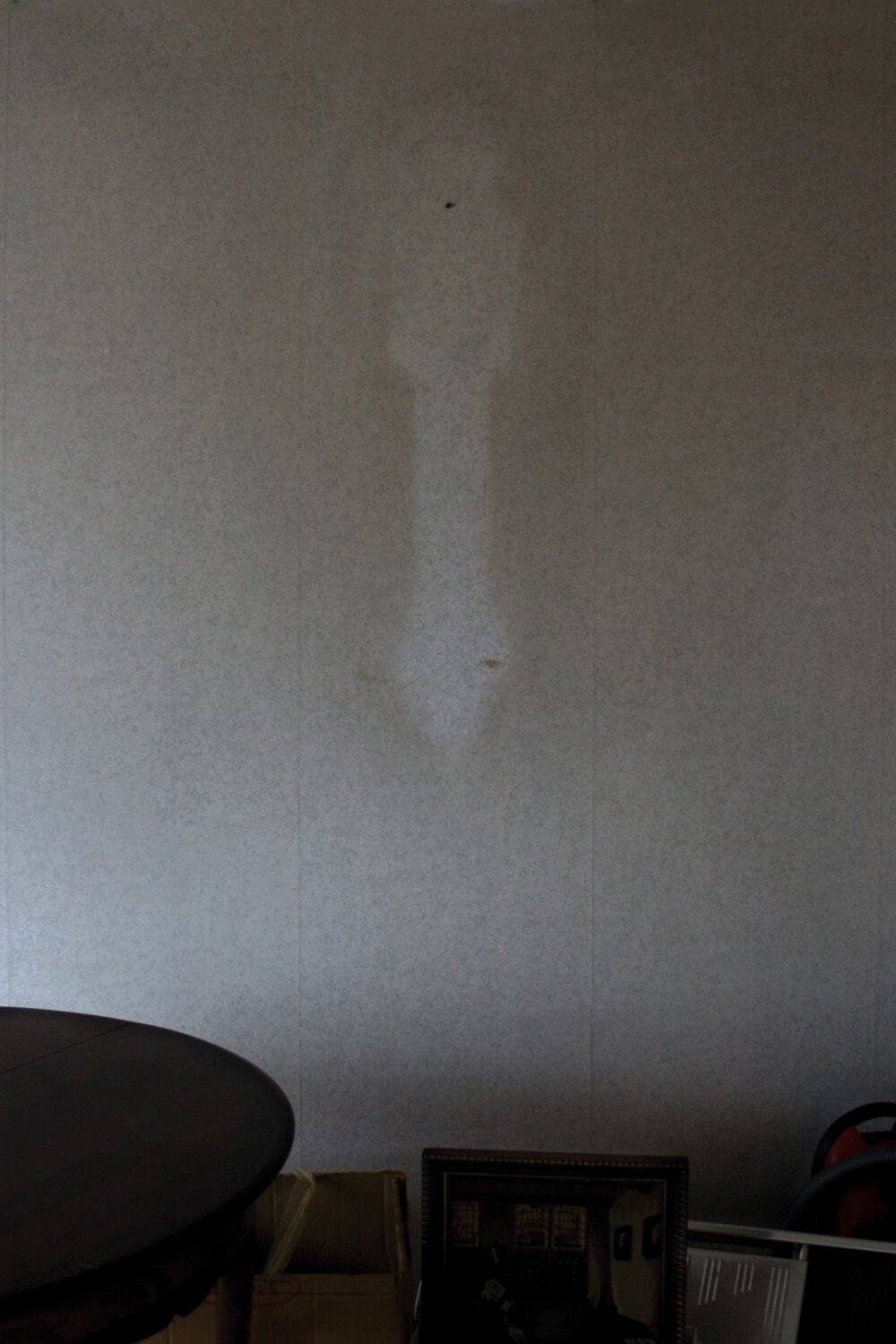Aesthetica Magazine, issue 127 (fall 2025)
12 page feature
Architecture is Satijn Panyigay’s (b. 1988) subject of choice. The Dutch-Hungarian photographer creates brooding images of empty museums, homes under construction, buildings during renovation and out-of-hours offices. These shadowy, analogue scenes, devoid of people and temporarily detached from their function, often resemble paintings or models. Flicking through the following pages, it feels as if we’ve been given exclusive access to these spaces, and are wandering – or trespassing – a gallery’s halls after closing time. Light sources are rare yet effective, bleeding through windows or doorways at the edges of the frame. Panyigay also depicts exteriors, as witnessed during solitary nocturnal strolls through her hometown of Utrecht and Frankfurt am Main. In these long-exposure shots, industrial buildings glow under the moon, street lamps or strip lights – inviting viewers into an enigmatic after-dark world.
Nadine van den Bosch in 1605 Magazine, no.2 Illusion (2025)
Nadine van den Bosch, director and co-founder of Young Collectors Circle—the leading platform for emerging art collectors—shares three art experiences that left a lasting impression on her. Explore the stories behind these personal favorites and what makes them so intriguing.
Over the years, I have followed the work of the talented Dutch-Hungarian photographer Satijn Panyigay (1988) with great interest. I was lucky enough to experience her work not only within the formal context of an exhibition but also in the intimate setting of her studio. These behind-the-scenes glimpses into the art world are very precious to me, offering a rare insight into the artist’s practice and revealing layers of the creative process that otherwise remain hidden.
When diving into Satijn Panyigay’s work, I was taken aback by the quiet yet profound sense of absence in her photographs. Her series Twilight Zone, that focusses on empty, deserted museum spaces, challenges us to see these familiar institutions as something otherworldly, almost uncanny. Looking at her work feels like stepping into an illusionary world where walls, corridors, and empty halls become the main characters. It’s as if Panyigay’s lens captures a reality just beyond our grasp—one that we might feel but can’t quite pinpoint.
Panyigay’s minimalist approach and subtle lighting play tricks on the mind. The absence of people within these museum spaces feels both calming and unsettling, urging us to question our relationship with these places. Her work challenges us to see museums not simply as containers for art but as structures with distinct identities, histories, and memories of their own. She subtly flips the roles: the museum is no longer just a backdrop or container; it becomes the subject itself, imbued with a presence that exists beyond its function. The haunting silence is not only about the lack of human presence but also about the weight of memory and time embedded within these seemingly empty walls. Through Panyigay’s lens, museums transform into living entities, their meaning shifting with our presence—or absence.
Her photographs draw you in, forcing a confrontation with emptiness that is at once intimate and remote. By stripping away the expected and leaving us with bare walls and soft shadows, Panyigay blurs the lines between reality and perception. In her spaces, we are reminded that what we see is often shaped as much by what is present as by what is conspicuously missing.
Frankfurter Rundschau
Review of the exhibition ‘Nightcall - The Frankfurt Edition’ at Galerie—Peter—Sillem by Anna Laura Müller, August 2024.
Frankfurt, quite quiet: Intruder into nighttime worlds
The artist Satijn Panyigay captures a feeling of silence in her photography series "Nightcall".
You almost wish it were a little darker when you look at Satijn Panyigay's photographs in the light-flooded rooms of the Peter Sillem Gallery. From outside, the sun and the sounds of passing traffic penetrate in, and yet the images that the young artist from Utrecht captured for her series "Nightcall" demand a kind of silence. The kind that only exists at night. When even in the offices in Frankfurt everyone has gone home. And the last person has turned off the light - or has forgotten it.
After Panyigay has focused on empty interiors in the past, such as empty museums and depots or still unoccupied rooms in newly built residential buildings, her attention is now turning to urban exterior facades. For this, the artist, born in 1988, has gone on nighttime trips in her hometown of Utrecht, but also in Frankfurt. She only used the light from street lamps and the moon for her analogue photographs. The images have something captivating about them, almost as if the silence and the gloom could swallow you up.
Some of the photographs show a schematically structured series of windows, some with only one brightly lit, surrounded by darkness. At first glance, everything seems like a stage set. Also because the scenes are completely devoid of people.
The buildings stand there deserted at night. There is still a light burning in some of the windows, but there is no sign of the people who filled the rooms and corridors behind them with life during the day. There is a melancholy in the images. A feeling of loneliness has settled over the otherwise hectic city at night.
And yet, on closer inspection, these nighttime scenes are not quite as sterile as the modern architecture and the darkness initially suggest. The rigid structure and perfection of the facade is broken here and there by cracks or stains of dirt that have formed and settled over time. Only those who get a little closer to the pictures discover these small signs of nature, which even the most urban environment cannot completely defend itself against.
The apparent calm in the pictures is not unbroken either. Although no people can be seen, they have left their mark. Perhaps someone has just walked through the glass staircase, from which the bright, artificially white light still shines out. Perhaps someone scurried around the next corner under the street lamp five minutes ago? Once you realize that the facades photographed are not backdrops, but only temporarily deserted buildings, you can certainly feel a sense of tension.
Because while Panyigay's pictures immerse city life in a gray detachment, you cannot help but ask yourself whether you, as the viewer, are actually penetrating a world that is not actually meant for you. It lies there so quietly and perhaps simply does not want to be disturbed. At least until the sun comes up again the next day.
Frankfurter Allgemeine Zeitung
Review of the exhibition ‘Nightcall - The Frankfurt Edition’ at Galerie—Peter—Sillem by Christoph Schütte, August 2024.
(German version under the English translation)
Cool Frankfurt Romanticism
FRANKFURT ⋅ Satijn Panyigay and her series “Nightcall” in the gallery of Peter Sillem.
It’s not something you see every day: that a young artist falls in love with a city like Frankfurt at first sight. But since Satijn Panyigay introduced herself as a new gallery artist at Peter Sillem a year ago, she has clearly been unable to get away from this city. What’s more, in view of the new series “Nightcall”, which is now the focus of her second solo show on the Main, her last stay in the Hessian metropolis to date can certainly be described as groundbreaking for the further development of her work.
The photo artist, born in Nijmegen, Netherlands in 1988, initially made a name for herself with interiors. With deserted, strangely claustrophobic atmospheres, such as those Panyigay finds in exhibition halls and corridors, in quiet niches or the depots of museums around the world. Pictures, always taken with an analogue medium format camera and in natural light, which at first you would doubt. Sometimes they appeared to the viewer as a trompe-l'oeil-like backdrop made in a hobby workplace, sometimes largely abstract and reduced to a composition of nothing but light and shadow; of brightness and darkness, of dead straight lines and surfaces organized horizontally here, vertically there. Now, for "Nightcall. The Frankfurt Edition", Panyigay has left the interior and the museum for the first time. And yet she finds comparably minimalist pictures that confuse the viewer for quite a while. And yet, if you know your way a little, you usually know where you are, you recognize the Silver Tower on Jürgen-Ponto-Platz or the somewhat aseptic-looking architecture on the former Degussa site. But here too it is difficult to believe the strict constructions lying there, abandoned like ruins. The world as it appears in Panyigay's Frankfurt pictures also seems completely abstract beyond the museum walls and in the public space. Sometimes one or two windows shine coolly into a dark night, sometimes not even that, and the next moment you would like to take the lantern on the street corner for the full moon reflected in the facade of an office building.
The city doesn’t get any more romantic than that in Panyigay‘s pictures. Which is perhaps why the sky-high hall of a skyscraper does not seem like a promise to the viewer, but rather the final sign of life in the abandoned metropolis. The last one to leave, they say, turns out the light. But even for that it seems long past time.
Aesthetica Magazine
article by Diana Bestwish Tetteh, July 2024
Midnight Serenity
Images impact how we feel. In 2015, Professor Stella Chan founded Project Soothe at the University of Edinburgh to research this concept in detail. The global citizen science project, now based at the University of Reading, involves building a bank of soothing photographs with the purpose of improving people’s mental health and wellbeing. Everyone is invited to submit their calming pictures to the study through the Project Soothe website. Visitors can run through as many images as they like in the Gallery, whilst ranking each on a sliding scale that asks “how soothing?” Rolling meadowlands, glittering lakes, sunset skies and baby kittens create a space that puts our minds at ease. Satijn Panyigay (b. 1988) aims to do the same with her photography. However, her focus veers away from the natural world and instead spotlights the beauty found in emptiness and simplicity. The Dutch-Hungarian lens-based artist is known for her images of vacant locations – office interiors, newly constructed homes, museum rooms – that inspire tranquillity because of their neat lines, plain colours and lack of distractions. Such scenes invite us to slow down and appreciate the everyday moments we would often overlook in our fast-paced modern lives.
Now, Panyigay calls us to notice the calming beauty of urban exteriors in her series Nightcall, which is on display at Galerie Peter Sillem, Frankfurt. The idea for this project came about whilst the lens-based artist was going on a number of nocturnal strolls through her hometown of Utrecht and Frankfurt am Main. Unintentional compositions in urban structures caught her attention and she decided to document them in this impressive collection of soothing night-time scenes. In one shot, we look up at rows of windows that seem to be filled to the brim with inky darkness. Marble or concrete tiles making a chevron pattern that surrounds these voids. It’s an image that is full of tonal contrasts, from the white frames to the grey slabs.
Like moths, our eyes flit to the light in such dark settings. Panyigay uses light to guide our eyes across compositions in Nightcall. For example, one piece shows rows of empty rooms in a multi-story skyscraper. Everywhere is dark except for one square opening, which is illuminated by a bright electric light from within. Who has left it on? Why? Paradoxically, the absence of people evokes a sense of presence here. We wonder about the people who will once again fill the office and bring life to the setting in the morning. Elsewhere, the glow from a streetlamp shows its warped reflection on a grid of glossy black tiles. It’s fascinating to see the light warp and disperse – like a mini nebula. Panigay blurs the distinction between moonlight and street lamps in these analogue photographs. In this way, contrasts emerge from the utilitarian landscape. Attuning our senses to the beauty of the night reveals an array of intriguing sights.
Being a viewer can be exhausting, especially when we are inundated every minute by a torrent of fresh images online. Nightcall is an invitation to slow down and enjoy the act of looking. We join Panyigay’s midnight stroll to observe with calmer eyes. The darker hours mean we have to choose what we want to linger on since not everything is illuminated. What do we gravitate towards visually? What associations spring to mind? And, how do they make us feel? Drawn to the ethereal realm of the night and its enigmatic yet peaceful ambiance, Panigay invites us into encounters with a parallel world that reflects our own.
Interview spring 2024 with Heidi Vandamme for Yoga International (Dutch Only).
Frankfurter Allgemeine Zeitung
By Christoph Schütte
17.02.2023
Photographs like a freshly made bed
This is where the artworks could hang. The reception would be set up there, maybe the museum shop here or in the corner the visitor cloakroom. However, the rooms, hallways and corridors that characterise Satijn Panyigay's still young photo-artistic work are mainly naked. And completely empty. Sober, sometimes only the shell, sometimes apparently just cleared out for renovation, and yet full of excit expectations. One could call it a unique promise, like a freshly made bed, even where it remains unclear where one is at all.
Fewer, because it is no longer exclusively museum spaces – the exhibition halls, for example, or the spectacular depot by Boijmans van Beuningen open to visitors in Rotterdam – that present the motifs of the Dutch artist, who is still little known in Germany; because the exhibits are missing or because in none of her series, with which Panyigay introduces herself as a new gallery artist at Peter Sillem, there is ever a single person to be seen. Here and there a narrow strip of light appears under the door, one suspects more than actually seeing it, a window or a glowing, bright shadow eats its way into the dark room. But mostly there is no hint, no matter how delicate, of an outside.
So that one would have good reason to doubt Panyigay's pictures, to take the recordings for a staging or for backdrops the size of a doll's house, as one knows from the photographs of Oliver Boberg or Thomas Demand. But the opposite is the case. When the artist, who was born in Nijmegen in 1988, takes a look at the cool corridors of a new building or fills the format with angles, alignments and bright white walls in the Kröller-Müller Museum, known for its Van Gogh collection, she takes the rooms as they present themselves.
And yet, photographed with the medium format camera exclusively with the given light, she finds interiors that can hardly be called anything other than painterly insofar, as they not only deal with questions of their own medium. These pictures speak of light and shadow, of space and surface, inside and outside, and of presence and absence.
But beyond such atmospheres, which are always subtle and never ostentatious, it are the details that refer to downright classic themes, especially in painting. And consequently to the blank space that holds each of Panyigay's series together.
Again and again, the motif of the grid appears, sometimes as a shadow, sometimes as a window cross or in the not yet occupied depot, one reads a painter's foil spread out on the floor as a photographic artistic study on the subject of materiality and baroque folds, or the depth of the space dissolves in the next instant in pure abstraction. Not much is missing and one would like to disappear from the world unnoticed in one of these rooms. The pictures, undoubtedly, will then come by themselves.
Cathy Jacob, Head of Presentations at Museum Boijmans Van Beuningen
Publication by Galerie-Peter-Sillem for the exhibition Inland, 14.01.-25.02.2023, Frankfurt am Main, Germany
Photographing What’s Not There
‘All men’s miseries come from not being able to sit in a quiet room alone’ - Blaise Pascal
A deserted museum with empty rooms, blank walls, no visitors, silent and void before a renovation. I could imagine no sadder picture until Satijn Panyigay showed me with her lens that there were other ways of looking at it.
Satijn Panyigay looks for beauty in empty buildings: old ones full of history, or, on the contrary, new buildings with a whole future before them. She searches lovingly with her camera and tripod for what does not seem to be there at first, scouring spaces for places that tell her more. She takes the pictures with her best friend and sparring partner, an analogue medium format camera. With it, she captures images a careless passerby would easily miss. She confidently turns what appear to be bare empty spaces into places with a charge, places where promise awaits. These are still images of seemingly stationary places, until you look closer.
She has the photos printed on rag paper using an inkjet printer in a photo lab, then she decides which tint of handmade frame will make each work complete. These fixed materials represent careful choices in the post-production process and the method of presentation. Now the work is ready to go out into the world, to meet outsiders who are open to being guided by the artist's eye. The viewer naturally starts looking for landmarks, for clarity. The brain sets to work, following the direction of her gaze, trying to fill in, recognise, understand. Where is this, what shadow is that, where is the light coming from, where do those surfaces lead to, how deep is that space behind it? Gosh yes, what a beautiful place in fact, I’ve never looked at it like that before. And then time slows down and even seems to pause for a moment.
A new space is created, a space of silence, tranquillity, where the viewer can let go. A space for contemplation. It is a personal experience, but at the same time, one with universal value. For those who allow it, it can be healing. This is what Satijn Panyigay also seeks for herself while photographing: the meditative silence in buildings, allowing her to step out of everyday existence and recuperate. The process is complete when she can convey this to the viewer.
Satijn Panyigay approached the museum in Rotterdam in 2019 on the eve of its renovation. She asked if she could photograph the empty building left behind; the deserted rooms without art, without people. Perhaps she would be able to feel the traces left by artworks and those thousands of visitors over the many years. She did not want to photograph it in a documentary way, but rather to capture the atmosphere. The reverberation, the resonance of a crowded museum.
Months later, she returned, the first phase of the renovation was over and again she recorded it in her photographs. She also captured the museum's new building in mesmerising images. Photography of expectation in historical and future locations.
What a privilege to look through the eyes of an artist.
Renske Imkamp, art collector, on Galleryviewer
‘Ask an Art Collector… Renske Imkamp” (March 2021)
I love how Satijn Panyigay captures light. I have often been drawn to her work at exhibitions.
‘ABLAZE’ (March 2021)
CHARRED
The drawing-like quality of soot plays a game with the eye when you look at the series (Living) room by Satijn Panyigay (Nijmegen 1988). Are we looking at a drawing or a photo? The title of one of the works, Charcoal Drawing, again misleads you. But anyone who knows Satijn knows the answer. She is known for her photos of abandoned spaces, such as the empty rooms of the currently closed Museum Boijmans Van Beuningen. She shot the series mentioned in the house of a young collector couple where a fire had raged: a tragic event with devastating consequences, but subsequently also the source for new art.
SUNLIGHT
About the moment the warm sunlight suddenly hit the charred walls, Satijn says: 'I saw the brightest white and the deepest, darkest black, captured in one image. The light and the dark need each other and cannot exist without each other. There is also something beautiful in all the misery, there is hope. ' She enhanced the drawing-like aspect of the images during her solo at Galerie Caroline O'Breen by treating the print and the surrounding wall with charcoal. It increased the game between the photo and the viewer's expectation that it was a drawing, but also brought the work closer to its origins; to the place where the images were created.
Merel van den Nieuwenhof, conservator Museum Jan Cunen/art historian, in Atelier Art Magazine
‘Ask an Art Collector… Ali Keles” (February 2021)
Satijn Panyigay graduated in 2010 from the HKU and often captures silences in spaces with a special context, in which light and dark form part of her shadow play. A photographer with an impressive eye for serenity, which was also evident in the series of photos she took of the vacant Museum Boijmans Van Beuningen in Rotterdam.
Ali Keles, art collector, on Galleryviewer
Flor Linckens, cultural historian and freelancer, on Galleryviewer
‘A museum with empty walls’ (October 2020, excerpt from full article)
In the new gallery space of Galerie Caroline O'Breen, the solo exhibition "Twilight Zone, Museum Boijmans Van Beuningen" by Satijn Panyigay will open on 24 October. In this exhibition, Panyigay takes us on an exploration of an empty Boijmans van Beuningen. She shows us that the museum is more than a series of white backdrops. How do the spaces in which we look at art influence the ways in which we experience art?
In 2000, American journalist Charles Jencks described in The Art Newspaper how museums, with their iconic buildings, super star artists and mega collections, are increasingly resembling cathedrals, in which art takes on an almost sacred function. But what is left of that when the walls are empty? In this exhibition in Galerie Caroline O'Breen, Satijn Panyigay invites us to look at the characteristic and recognisable empty spaces of Museum Boijmans Van Beuningen. She was allowed to capture the museum in 2019, just before the museum closed its doors for seven years for a renovation. Boijmans has been located in the building for 85 years, so the walls breathe a certain history. Panyigay shows us a side of the museum that few people have seen: with bare walls that radiate almost something fragile because you know they shouldn't be empty. That creates a certain tension, because what is a museum without art? The photos are part of a larger project in which Panyigay captures famous Dutch contemporary art museums in this almost aimless period, in between exhibitions. She previously recorded the Kröller-Müller Museum this way. She shows us a museum without art and without visitors, in which the museum seems to lack function and perhaps even authority.
In her photos of Boijmans van Beuningen, you can only see a few traces of what was once on display: a single nail or discolouration on the wall. Panyigay asks you to allow your imagination to fill in the gaps. As in her other work, she proficiently plays with light and darkness, with a great sense of melancholy and, in Boijmans' case, perhaps even referring to the nostalgic feelings that people experience while seeing these photos, especially considering that a physical visit to the museum museum will be out of reach for so long. The background of the museum suddenly becomes the foreground. Panyigay says she is looking for a certain "presence" in this apparent emptiness, but what exactly is that presence, that essence, without art? Panyigay invites you to make your own interpretation.
ZOOM Magazine 2022
Showcased is a new series - from a wider project - of Satijn Panyigay dedicated to the filling of empty spaces of Dutch museums, with contemporary artworks. This series is the continuation of the previous one which documented the Boijmans Van Beuningen Museum, closed for renovation, and its depot. The Kröller-Müller museum is here the new protagonist. It was captured when it was void of works and people, in a dead period between two exhibitions. A twilight zone, a purgatory state that visitors cannot experience. The artist’s compositions are minimalist, all delicately orchestrated with subtle colours and architectural abstract geometries.
Her tranquil images are nearly monochromatic and can be described as pastel drawings look-alikes. They highlight empty spaces with no people and perfectly balance light and shadow, figurative and abstract, rhythm and quietness. The feelings we experience range from hope to acceptance, from solitude to fear, tension and silence.
The artist, born in 1988, is half Dutch half-Hungarian, and she lives and works in Utrecht. Her works are part of collections at Museum Boijmans Van Beuningen, Museum Tot Zover, Museum Van Bommel Van Dam, Gemeentemuseum Weert, KPMG; Reyn van der Lugt, Sgabello Collection and BlueKnowledge Art Collection.
Photo31
ExpoTalk #1: Twilight Zone (The Kröller-Muller Museum)
Satijn Panyigay – Galerie Caroline O’Breen
door: Ioana Cobzaru
Vanuit een onderbelichte positie ontwaakt de ziel van het gebouw
De stilte van een kathedraal, fluweel zachte beelden, pure poëzie. Dit kwam in me op toen ik galerie Caroline O’Breen in Amsterdam binnenkwam. Het was vroeg in de middag op de vernissage en Satijn Panyigay kwam me tegemoet met een lach waarin ik enthousiasme, maar ook gezonde spanning en de stilte voor de storm kon lezen. Logisch, er ligt ook zo veel moois in het vooruitzicht, want vanaf deze dag is iedereen welkom op haar solo-expositie ‘Twilight Zone’ die verrassende beelden laat zien van een verlaten Kröller-Muller Museum.
Bij een leegstaand museum denk ik al snel aan afstand en geometrie, maar de beelden van Satijn tonen een verrassende zachtheid. Ze weet het licht op bijzondere wijze vast te leggen, van diffuus tot contrastrijk, maar altijd als een zachte deken om de rechte lijnen van de ruimte heen. Als ik ernaar vraag legt Satijn uit: ‘ik werk altijd met het aanwezige licht. Vaak is dat daglicht dat door de speciaal ontworpen plafonds en ramen naar binnen schijnt, maar soms staat er een verdwaald zaallicht aan en dat gebruik ik dan ook. Ik vind de zoektocht naar schoonheid op plekken die voor de meeste mensen niet zichtbaar zijn heerlijk, ik voel me dan altijd als Alice in Wonderland’.
Het is vooral bijzonder hoe deze kunstenaar speelt met licht en donker. Bij een aantal foto’s begint ze met een bewust onderbelicht beeld om vanuit daar de contouren van de omgeving langzaam te laten ontwaken, met her en der een plukje zacht licht. Zijn die ruimtes wel zo leeg als ze lijken? Satijn: ‘In een leeg gebouw voel me langzaam één worden met de stilte. Er is dan altijd iets voelbaar dat verder gaat dan de muren die je ziet, een bepaalde energie of essentie. Niet per se van dat wat voorheen de ruimte vulde, maar eerder de ziel van het gebouw zelf. Waar de muren en ik elkaar herkennen in iets eenzaams, dat is wat ik fotografeer.’ Satijn weet die essentie met schoonheid en gevoel te vertalen naar beelden die ons als kijker verstild achterlaten in een volle galerie met kunst die het tegenovergestelde laat zien.
Article about photography fair Haute Photographie (2020)
Silent environments with cause for contemplation: the work of Satijn Panyigay (1988) allows the viewer to calm down. At the same time, her photos have something mysterious and oppressive about them. It is the play of light, shadow and reflection that gives her photos an intriguing quality. Panyigay is fascinated by architectural spaces and plays with their perception. One of her latest projects is a documentation of a fire that reduced the living room of a young couple of art collectors to ashes. Her photos of this show the beauty of destruction.
RESIDENCE Magazine
De Volkskrant, October 2019
ENGLISH
Satijn Panyigay does not show the drama of the house fire,
but the silence afterwards
Afterwards you can of course say that the circle is complete. But that was not exactly what Sam van Rooij (29) and Francine de Ronde (29) were thinking about when, the day after the fire in their house, in January of this year, they decided to ask photographer Satijn Panyigay (31) if she might be interested in photographing their blackened living room. Maybe more so they thought: how can we turn this terrible event into something positive, something beautiful?
In addition, the white spots on the walls, where their artworks had previously hung, reminded them of a photo by Panyigay from the Behind Death's Door (2010) series. That photo, part of Van Rooijs art collection and now also affected by smoke and heat, shows the wall in a house on which a cupboard and objects that stood in the same place for years left their white silhouettes behind. For her graduation project at the Utrecht School of the Arts, Panyigay, a photographer with an even greater penchant for melancholy than photographers usually already have, set out with a company that clears out homes after the residents have died. In half-empty houses she searched for the insignificant remnants of human existence - a shower rack, a stain, a mirror, a crack in the wallpaper - that had suddenly become so much more meaningful after death.
It is therefore not surprising that after the fire in their house, Van Rooij and De Ronde involuntarily had to think about Panyigay's work. But the fact that the couple then gave the young photographer the opportunity to come and take pictures, because such a crazy empty house fits so well into her oeuvre, shows a wonderful flexibility of mind and a great love for art. The result of that collaboration can now be seen in gallery Caroline O'Breen in Amsterdam.
Panyigay did not focus on the drama of the fire, but on the silence afterwards. On the walls that had been painted matte black by the soot, and in the places where it could not reach: the seams, the corners, and behind the works of art. She kept taking photographs until the house had become a bit of hers too.
There is a beneficial rest in those photos. It is as if the damaged house is recuperating under Panyigay's attentive gaze. That calmness and concentration is all the more remarkable when you consider that the photographer got the job done within a few hours and in the midst of cleaning crews. And just when she was about to leave, she said at the opening of her exhibition, she had already packed her camera, the sun was coming out. It shone in through the window and lit up the black wall. That photo now forms the hopeful conclusion to the exhibition. In retrospect - yes, afterwards that circle is nicely closed.
Satijn Panyigay: (Living) room. Until 5/10 in gallery Caroline O'Breen, Amsterdam.
Sam van Rooij, art collector, on Galleryviewer
‘Ask an Art Collector.. Sam de Rooij’ (March 2020)
Satijn Panyigay and Bastiaan Woudt are my favourite photographers!
‘The struggle between the figurative and abstract’
Satijn Panyigay understands the art of expressing real emotions such as loneliness and fear, anticipation and resignation through an abstract play of light and dark. A light shining in a corner, a white spot on a wall, a doorway. It isn’t so much what you see, but it is the way it is presented through a specific use of light and dark that triggers the sensation of tension or stillness. The Afterglow series is a good example of a series of - almost - abstract photos in which the emptiness seems to emphasize the absence of people. Some places are reminiscent of a parking garage or a basement, but the abstraction almost invariably beats the figuration, the same way the atmosphere overrides the plot.
Melle Daamen on Galleryviewer
‘Klerkx buys art: five works of art under € 500’
I notice a diptych in the shop window of the Caroline O’Breen gallery. It concerns the photos "Ágak" (tree branches) & "Törülköző" (towel) from the Melankólia" series "by artist Satijn Panyigay, a true master in celebrating everyday objects and situations. The simplicity and nostalgia that burst from the photos are irresistible. I park my bike and while placing my hands between my forehead and the gallery window I try to get as close as possible to the images. I don't want to miss a detail. In Satijn's work I recognize the sensitivity to the beauty or the peculiarity of a particular moment, such as a sunbeam on a towel hanging to dry or a twig dying on a bed. Somehow, I tend to "read" her photos as a "mood board" that resonates with my emotional life. It makes me happy and quiet at the same time and I decide to go for a ginger tea in a tea room, right next to the gallery. As I stare outside, I think of the image of the pair of scissors on the bed. How beautifully life and death are depicted here in the combination of a twig, symbol of life and scissors that can make the difference between dead and alive, between then and now.
Manuela Klerkx, art agent, on Galleryviewer
Flor Linckens, cultural historian and freelancer, on Galleryviewer
‘Introspection in turbulent times’
Dutch photographer Satijn Panyigay teaches us to embrace melancholy and depression and to see the beauty of it. She photographed houses where a beloved pet has recently died, but also houses where a violent fire has just raged or other (often impersonal) spaces that radiate loneliness and sadness. Yet, these spaces tend to have an intense architectural beauty, which can have an almost abstract feel.
Sven Schlijper-Karssenberg, art collector, on Galleryviewer
‘Ask an Art Collector..Sven Schlijper-Karssenberg’
Who are your favourite artists?
Satijn Panyigay: We saw Satijn's work early on and fell in love with it. I bought a piece of work from her as an alternative engagement ring for my wife. We own several photos and artist books from Satijn, because she is one of the best photographers in the Netherlands.
Maarten Moll, het Parool (2017, Dutch text only)
Duidelijk is te zien dat er een klok aan de wand heeft gehangen. De tijd heeft om de afdruk heen het behang verkleurd. Straks is ook het behang weg, of overgeschilderd, en herinnert niets meer aan degene die er woonde. Het is een intrigerende foto, die iets onnoemelijk triests heeft. Zo zijn er meer in de serie Behind Death’s Door van de Nederlands-Hongaarse fotografe Satijn Panyigay.
Panyigay fotografeerde voor de serie uit 2011 in huizen van mensen die kort daarvoor waren overleden. Ze deed dat terwijl het huis door een bedrijf werd ontruimd. Omdat de overledene geen familie meer had, of omdat familie daar geen tijd voor had, of ze niet geconfronteerd wilden worden met sporen van iemand die er niet meer is.
En die sporen zijn er natuurlijk, dat laten de foto’s duidelijk zien. We zien een kast, half open. Een lege plank, een roede waar geen kleerhangers met overhemden of jurken meer aan hangen. Toch is het geen inkijkje in een leeg leven, want de kast zelf heeft ook geschiedenis. Waar is de kast gekocht? Wanneer? Heeft hij altijd op die plaatst gestaan? Wil niemand die kast? Waarom niet?
Een bed met een kaal matras, een foeilelijke stoel met diverse kussentjes. Muren waar lijsten aan hebben gehangen. We zullen nooit weten wie in dat bed lagen, hoe in die stoel is gezeten, waar de levenden naar keken.
Het zijn laatste sporen, geschiedenissen, verhalen. Misschien duikt de kast nog eens op in iemands herinnering, tot het voor altijd zal worden vergeten en wordt gewist door de tijd.
Wat zeggen deze alledaagse spullen en voorwerpen in een al bijna ontruimd huis? Het is een hele andere kijk op de dood die Panyigay laat zien. Doodsfotografie zonder lichamen.
Nathalie Maciesza, art historian and founder of de Kunstmeisjes
We see something very commonplace in this picture: a light where normally, advertising posters are displayed. By showing just the empty light, the photographer reveals a sense of beauty without the poster, creating a somewhat mysterious image. The strong contrast between light and dark really draws you towards the photograph. What you then see, can change by the day and depending on your mood. Perhaps one sees an unfulfilled, empty space. Or, as an alternative to ‘forced on us’ advertising, you might see a spotlight on your fantasy scene or a metaphorical light bulb shining through the dark. This photograph is fascinating in its simplicity - I would love to have it in my home.
Rick Berends, philosopher (Dutch text only)
Een aftandse koelvitrine met grauwe stukken vlees. De stellage licht op voor een benauwend hekwerk. Daarachter een donker niets, een zwart, oneindig gat. Een vreemd stilleven dat opdoemt waar het leven het toneel allang verlaten heeft. Met stillevens kan een kunstenaar zijn behendigheid oefenen en tonen. Maar in dit stilleven voel ik geen aanwezigheid van de maker. Het is verlaten. Leeg.
Maar ik word naar binnen getrokken. Het ruikt muf en voelt vochtig. Een zachte zoem bromt rond de stalen kast. Ik voel me vervreemd. Waar ben ik? Als ik me omdraai, zie ik dan iets? Is daar iets? Het beeld associeer ik met de wereld maar heeft zich daarvan los gemaakt. Het is een abstractie geworden. Staat op zichzelf. Een Ding an sich. Maar het wil dat niet verraden. Handgeschreven prijskaartjes wekken een suggestie van interactie en communicatie. Het hint naar menselijkheid, maar ik geloof het niet. Het is er een simulatie van.
Hoe langer ik kijk, hoe meer Darab hús me in haar greep houdt. Zoals het vleeswaar en de vitrine zijn losgezongen van een winkel waar mensen daadwerkelijk zorg droegen voor producten, waar geld over de toonbank ging en praatjes werden gemaakt, zo voel ik me meer en meer losgezongen van de persoon die dagelijks werkt, doet, liefheeft, eet, lacht.
De natuur is onverschillig. En hier zie je de mens en haar voortbrengselen als onderdeel van die onverschillige natuur. Een wezen dat doet en is op de automatische piloot zonder dit aan zichzelf te willen toegeven. Een wezen dat wil overleven, maar er ook iets van wil maken, ja zelfs zin zoekt. Tevergeefs. Maar dat baat niet, het is ok.
Vaak roept kunst emoties op. Het vertedert, maakt boos of ontroert. Maar soms is het fijn als ze je losweekt van gevoel. Want gevoel is tijdelijk. En soms wil je niet tijdelijk zijn. Soms wil je voelen dat er meer is dan dat. Dat er iets is dat daarvan losstaat. Het oneindige of het lege, het eeuwige, het onophoudelijke of het niets. Dat voelen doet wat ik het liefst heb dat kunst doet. Het troost.
Guus Sluiter, Brancheblad Uitvaartzorg, mei 2016, thema: jongeren
De dood boeit jongeren: muzikanten, kunstenaars, fotografen. Veel willen dodenprofessional worden. Ze zijn welkom, want fris en fruitig. Maar er ligt wel een keurslijf klaar. Hoe bevecht je je eigen plek? Satijn Panyigay (toen 21) fotografeerde huizen die worden leeggeruimd. Je ziet sporen van een voorbij leven. Een leeg rekje tegen de muur. Afdrukken van planken. Gaatjes van schroeven waar ooit foto’s hingen. De bewoner is verdwenen, herinneringen glippen door de kieren. Straks worden de gaatjes gevuld. Een nieuw behang, een nieuwe laag verf. Kindergeluiden vullen de ruimte. Zo jong – en dan zo’n werk maken. Kwaliteit kent geen leeftijd. Dáár is je plek.
Babs Bakels, Museum Tot Zover Amsterdam (2011)
The melancholic photoseries Behind Death’s Door shows the houses of recently deceased people of whom the relatives chose a specialized company to clear out their homes. Panyigay went along several times to investigate death more.
The photos are hermetic, there is no contact with the outside world, which results in an oppresive atmosphere of loneliness and nostalgia. Trivial objects are the last remains of a passed life. Traces are being removed, a preview of the fading of memories.
Eventually falling into absolute oblivion is the frightening fate of each individual. Eternity comes down to a constant movement of people who constantly die.

